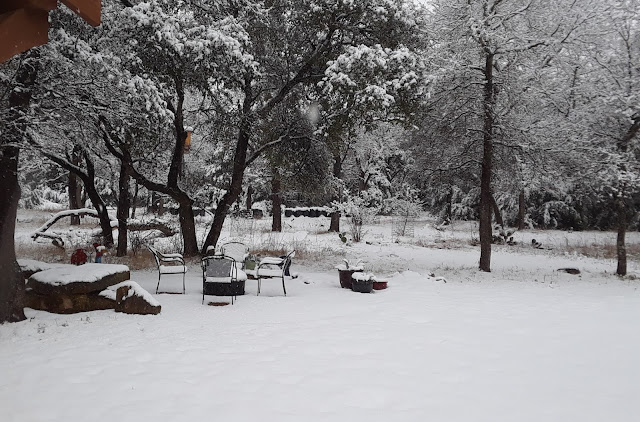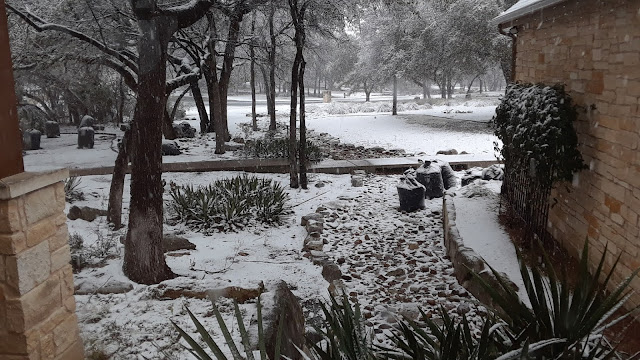We've already had more than our fair share of cold snowy weather for the winter of 2021. And the worst cold spell in decades is just hours away.
In January, we experienced a snow event that resulted in about 3 inches of snow, which was the heaviest snowfall we've experienced in the 30 years that we've been here in central Texas.
 |
| Our January cold snap created a winter wonderland. |
 |
| It looks pretty, until you need to go somewhere. |
The snow lingered for about three days which is unusual. A normal cold snap for us only lasts a day or so, and then a warm spell arrives to make you forget it was ever cold at all.
Today a polar front is barrelling towards central Texas. The coldest weather since the 1960's is predicted to arrive tonight. We may get an additional 3 to 6 inches of snow!
Before our January storm, we had a lot of visitors to the backyard water feature.
| A pair of foxes. |
| Our elusive friend, the ring-tailed cat was back. |
| How many raccoons can you find? |
| Wile-E-Coyote... and yes, roadrunners visit our property. |
| A buck visits the watering hole. |
| Are you lookin' at me? |
| Just stopping by for a drink. |
| Surprise! You're on the game camera! |
This year we spotted the largest number of migrating Robins we had ever witnessed. The Robins drink the water we provide, but they don't eat the seeds or use the suet feeder. They hop around scanning the ground, hoping to find grubs, worms and similar insects.
| There may be 11 Robins in this photo. |
| In this shot I counted 13 Robins. |
In addition to the backyard wildlife at the water feature, we also have lots of activity at our new bird feeder which provides suet for the cold, hungry birds.
| Tufted Titmouse. |
| Tufted Titmouse. |
| A Bluebird caught at the instant of leaving the feeder. |
We have been observing many Bluebirds at the feeder, some feeding while others wait their turn. The fat in suet will provide their metabolism with energy to produce warmth. They're going to need it soon, when the coldest-ever polar front descends from the north.
| Bluebird. |
| Hang on, little friend. |
Ladderback Woodpeckers are also frequent visitors to the feeder, they especially love suet.
| A female Ladder-back Woodpecker lacks the red colors of the male. |
In the photo above and the one below, the female Woodpecker is on this side of the feeder, and the male is on the opposite side. These birds are probably a mated pair.
| Here, the female by herself. |
| Here's the male by himself. |
That's all we have for now. It's time to hunker down and steel ourselves for the cold blast from the north. Hasta luego amigos!